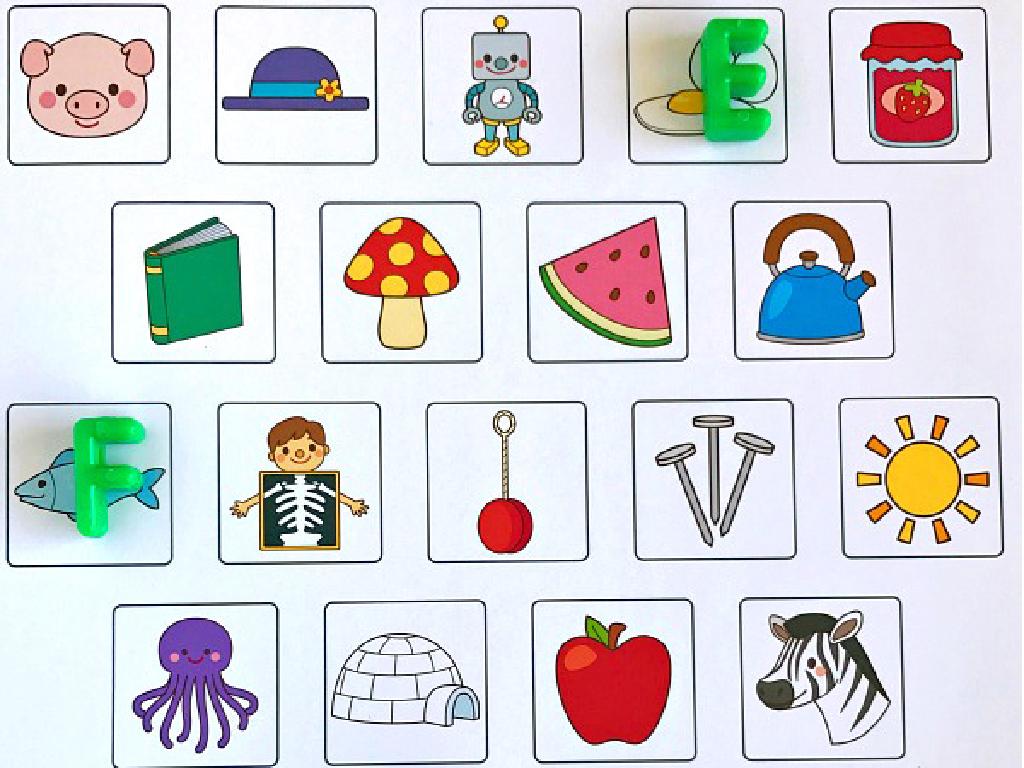Divide Fractions
Subject: Math
Grade: Seventh grade
Topic: Operations With Fractions
Please LOG IN to download the presentation. Access is available to registered users only.
View More Content
Today’s Adventure: Dividing Fractions!
– Grasp the concept of fractions
– Understand fractions as parts of a whole
– Learn to divide fractions
– Flip the second fraction and multiply
– Master fraction division steps
– Follow the steps: invert and multiply
– Aim for fraction division expertise
– Practice leads to mastery by end of session
|
This slide introduces the concept of dividing fractions, which is a crucial skill in mathematics for seventh graders. Begin by ensuring that students have a solid understanding of what fractions represent parts of a whole. Then, explain the process of dividing fractions by multiplying by the reciprocal of the divisor. Walk through the steps of inverting the second fraction and multiplying it by the first. Emphasize the importance of practice to achieve mastery, and assure students that by the end of the lesson, they will be more comfortable with fraction division. Provide examples and exercises for students to work through, and be ready to offer support and clarification as needed.
Understanding Fractions
– Fraction: Parts over whole
– A fraction represents a part of a whole, like 1/2 of a pizza.
– Everyday life fraction examples
– Examples: 3/4 of a gallon of milk, 2/5 share in a game.
– Fractions signify division
– Understanding that 3/4 means 3 divided by 4 helps in operations.
– Simplifying complex divisions
– Fractions simplify division of quantities not easily divisible.
|
Begin with a quick review of what a fraction is, emphasizing the concept of ‘parts over whole’. Use relatable examples to show fractions in everyday life, such as portions of food or shares in games. Highlight that fractions are another way of representing division, which can be a more intuitive way for students to understand dividing quantities. Explain how fractions can simplify complex division problems by breaking them down into smaller, more manageable parts. Encourage students to think of fractions as both parts of a whole and as division statements to strengthen their conceptual understanding.
Multiplication Review Before Dividing Fractions
– Recall multiplying fractions
– Multiply numerators and denominators
– If we have 2/3 * 4/5, we multiply 2*4 and 3*5
– Simplify the resulting fraction
– Reduce 8/15 to its simplest form if needed
– Practice with examples
– Try 1/2 * 3/4 and simplify your answer
|
Before diving into dividing fractions, it’s crucial to review multiplication of fractions as it’s a foundational step. Remind students that when multiplying fractions, they should multiply the numerators together and the denominators together. Emphasize the importance of simplifying the product to its lowest terms, which may involve finding the greatest common divisor. Provide practice examples for the students to work through, such as 1/2 * 3/4, and guide them through the process of simplification. This review will help solidify their understanding and prepare them for learning about division of fractions.
Understanding Division of Fractions
– Division as inverse of multiplication
– Dividing fractions by reciprocals
– To divide by a fraction, multiply by its reciprocal instead
– What is a reciprocal?
– Flip the numerator and denominator of the fraction
– Practical application
– Use this method to solve real-world problems involving fraction division
|
This slide introduces the concept of dividing fractions by relating it to multiplication, which students are more familiar with. Emphasize that division is essentially the multiplication of one number by the reciprocal of another. Ensure students understand the term ‘reciprocal’ and how to find it by flipping the numerator and denominator of a fraction. Provide examples to illustrate this, such as dividing 1/2 by 3/4 by multiplying 1/2 by the reciprocal of 3/4, which is 4/3. Encourage students to practice with different fractions and apply this knowledge to solve problems they may encounter in everyday situations, such as cooking or dividing resources.
Dividing Fractions: Step-by-Step
– Find the divisor’s reciprocal
– Flip the divisor fraction over
– Multiply by the reciprocal
– Dividend times divisor’s reciprocal
– Simplify the resulting fraction
– Reduce the fraction to its simplest form
|
When teaching students to divide fractions, start by explaining the concept of a reciprocal what it is and why it’s used in division. Demonstrate the process of flipping the divisor to find its reciprocal. Then, guide students through the process of multiplying the dividend by this reciprocal to perform the division. Emphasize the importance of simplification, showing how to find the greatest common factor to reduce the fraction. Provide examples and practice problems, such as dividing 1/2 by 3/4, where students will find the reciprocal of 3/4 to be 4/3 and then multiply 1/2 by 4/3 to get 4/6, which simplifies to 2/3.
Dividing Simple Fractions
– Dividing fractions example
– Let’s divide 1/2 by 1/4
– Step-by-step solution
– Invert the divisor and multiply: (1/2) ÷ (1/4) becomes (1/2) * (4/1)
– Interpret the result
– Understand that (1/2) * (4/1) equals 2, meaning 1/2 is twice as large as 1/4
– Practice problem
– Try dividing 3/5 by 2/3 on your own
|
This slide introduces students to the concept of dividing fractions by working through a simple example. Start by explaining that dividing by a fraction is the same as multiplying by its reciprocal. Walk through the process step-by-step, showing how to flip the second fraction and change the division sign to multiplication. Emphasize the importance of understanding the result, not just computing it. For instance, explain why 1/2 divided by 1/4 is 2, reinforcing the concept that 1/2 is twice as large as 1/4. Conclude with a practice problem to solidify their learning. Encourage students to visualize the fractions to better understand the relationship between the numbers.
Dividing Complex Fractions
– Example: 3/4 ÷ 2/3
– Apply learned division steps
– Recall the steps: Invert the divisor and multiply
– Multiply by the reciprocal
– 3/4 x 3/2 = 9/8 after flipping 2/3
– Verify the solution
– Use multiplication to check: 9/8 x 2/3 should equal 3/4
|
This slide focuses on applying the steps for dividing fractions to a complex example. Start by presenting the problem 3/4 divided by 2/3. Remind students of the steps for dividing fractions: invert the divisor and multiply. Walk through the multiplication of 3/4 by the reciprocal of 2/3, which is 3/2, to get the answer 9/8. Emphasize the importance of checking work by multiplying the result, 9/8, by the original divisor, 2/3, to see if it equals the original dividend, 3/4. This reinforces the concept and ensures students understand the process of division and verification in the context of fractions.
Dividing Fractions: Practice Time
– Solve the practice problems
– Work independently or with a partner
– Review solutions as a class
– Understand each step
– Remember to invert the divisor and multiply
|
This slide is designed to engage students in active practice of dividing fractions. Provide a set of problems for students to solve, encouraging them to work at their own pace or collaborate with classmates. This collaborative approach allows students to discuss strategies and learn from each other. After a set amount of time, reconvene as a class to go over the answers, ensuring to explain each step of the process. Emphasize the importance of inverting the divisor and multiplying when dividing fractions. Offer guidance and support throughout the activity, and be prepared with additional problems for students who finish early or need extra practice.
Class Activity: Fraction Division Relay
– Form teams for the relay
– Each member solves a step
– Work together to divide fractions
– Break down the division process into clear steps for each member
– Race to get the correct answer
|
This activity is designed to encourage teamwork and understanding of fraction division. Divide the class into small groups, and give each team a fraction division problem. The problem should be broken down into steps such as flipping the second fraction for reciprocal, multiplying the numerators, multiplying the denominators, and simplifying the result. Each team member will be responsible for one step in the process. The first team to complete all steps correctly wins. Make sure to prepare different sets of problems for each team to prevent copying. This will help students understand the sequence of actions in fraction division and reinforce their skills through practice and collaboration.
Conclusion & Homework: Mastering Fraction Division
– Congratulations on learning fraction division!
– Recap: Reciprocal, Multiply, Simplify
– Invert the divisor, then multiply it by the dividend.
– Homework: 10 division problems
– Ensure each problem is simplified to its lowest terms.
– Practice makes perfect!
|
Well done on completing today’s lesson on dividing fractions! It’s important to remember the key steps: find the reciprocal of the fraction you are dividing by, multiply it with the other fraction, and then simplify the result if possible. For homework, students are assigned 10 problems to reinforce their understanding and ensure they are comfortable with the process. Encourage them to try simplifying the fractions before multiplying to make calculations easier. Remind them that practice is essential to mastering math skills, and this homework will help solidify their learning from today’s lesson.






